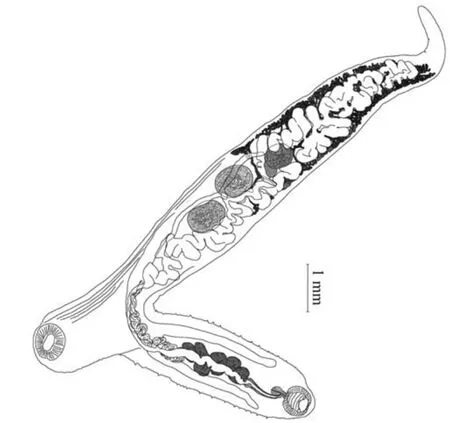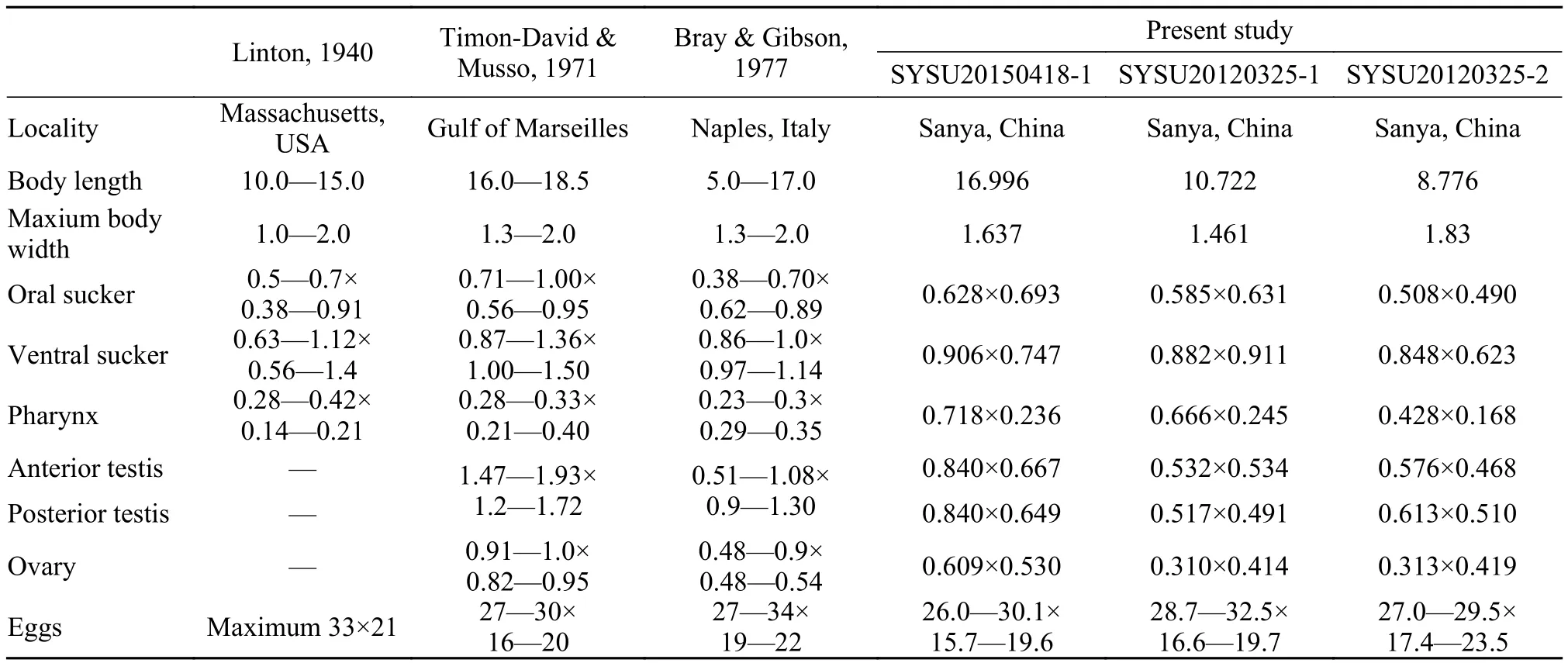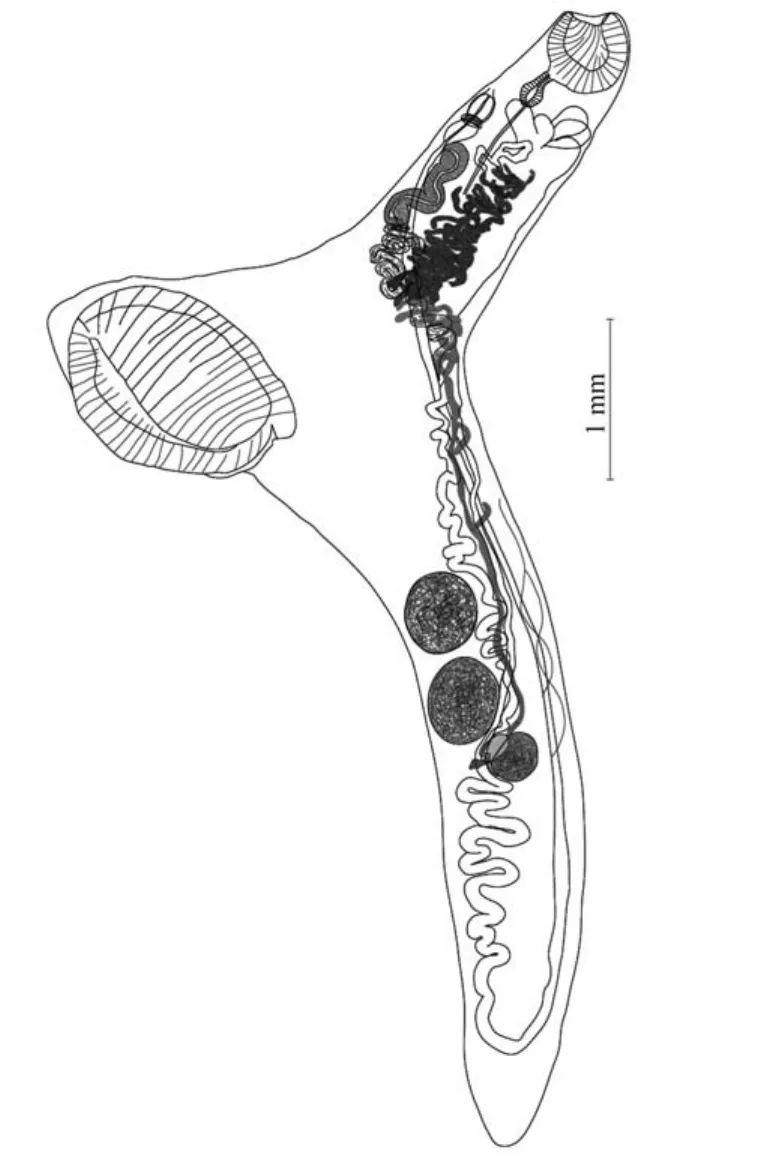TWO NEW RECORDS OF GENERA,WITH REDESCRIPTION OF ACCACOELIUM CONTORTUM(RULDOLPHI,1819) AND ACCACLADOCOELIUM PETASIPORUM(ODHNER,1928)(DIGENEA:ACCACOELIIDAE)
2016-11-12ZHANGShuaiLIUShengFaandYANGTingBao
ZHANG Shuai,LIU Sheng-Faand YANG Ting-Bao
(1. State Key Laboratory of Biocontrol and Guangdong Provincial Key Laboratory for Improved Variety Reproduction of Aquatic Economic Animals,School of Life Sciences,Sun Yat-Sen University,Guangzhou 510275,China;2. School of Life Sciences,Xiamen University,Xiamen 361005,China)
TWO NEW RECORDS OF GENERA,WITH REDESCRIPTION OF ACCACOELIUM CONTORTUM(RULDOLPHI,1819) AND ACCACLADOCOELIUM PETASIPORUM(ODHNER,1928)(DIGENEA:ACCACOELIIDAE)
ZHANG Shuai1,LIU Sheng-Fa2and YANG Ting-Bao1
(1. State Key Laboratory of Biocontrol and Guangdong Provincial Key Laboratory for Improved Variety Reproduction of Aquatic Economic Animals,School of Life Sciences,Sun Yat-Sen University,Guangzhou 510275,China;2. School of Life Sciences,Xiamen University,Xiamen 361005,China)
Two species of the Accacoeliidae Odhner,1911,Accacoelium contortum(Ruldolphi,1819) and Accacladocoelium petasiporum(Odhner,1928),are redescribed based on new materials collected from the intestine of the sharptail mola Masturus lanceolatus(Lienard) off the coast of Hainan Island in the South China Sea. Characteristics of uterus of the two species are different from previous descriptions,and the specimens of A. contortum were collected in intestine rather than gills as reported previously. Both of these two species and their genera are firstly recorded in China.
Accacoeliidae; Accacoelium contortum; Accacladocoelium petasiporum; Masturus lanceolatus;New geographical record of genus and species
The Accacoeliinae Odhner,1911 was initially erected by Odhner(1911) and subsequently raised to family level as Accacoeliidae by Dollfus(1923)[1]. Several different classifications had ever been proposed before the widely accepted revision was made by Gibson[2]based on Bray and Gibson[1]. Accacoeliidae includes two subfamilies,Accacoeliinae Odhner,1911 and Paraccacladiinae Bray and Gibson,1977,according to the form of the vite-llarium,the presence or absence of anterior ceca and a uroproct,and the position of Mehlis' gland. A total of 27 valid species(excluding one Taxon inquirendum) belonging to eight genera are currently included in the Accacoeliidae[3]. This family have always been considered an unusual group[2]since the majority of taxa were found from same species of fish,the sunfish Mola mola. In China,however,except one unidentified species of Odhnerium sp. Yamaguti,1934 collected from Mola mola off southeastern Taiwan Strait,other six species of accacoeliids in four different genera,were collected from hosts of different families[4—6].
During the study of fish parasites of South China Sea,several individuals of sharptail mola Masturus lanceolatus were found in the fish market in Sanya,Hainan province,China,from which three species of accacoeliid were collected. Besides,two species of accacoeliids belonging to two different genera Accacoelium(Rudolphi,1819) and Accacladocoelium(Odhner,1928) were found in the sharptail mola Masturus lanceolatus. They were redescribed because these two genera are first reported in China and some differences in morphologies were observed in our newly collected specimens[1,4—6].
1 Materials and methods
Brief introduction of author:Zhang Shuai(1989—),male,Hunan Province; Ph. D graduate; major in pathology of aquatic economic animals. E-mail:zhangsh29@mail.sysu.edu.cn
Correspoding author:Yang Ting-Bao(1963—),E-mail:lssytb@mail.sysu.edu.cngeneans specimens were collected alive,washed in normal saline for several times,and individually fixed by using AFA solution on a glass slide under a coverslip at room temperature. Specimens were then removed from the slides and preserved in 75% ethanol solution for further treatment. All specimens were later rinsed in several changes of water before being stained in Grenacher's alum carmine,dehydrated in an ethanol gradient,cleared in clove oil and mounted in neutral Canada balsam. Illustrations were prepared with Adobe Illustrator CS6 based on the picture of merged photos captured under ZEISS AX10 microscope. Due to the large pedunculate ventral sucker,all specimens were mounted laterally or sublaterally. All measurements(eggs were micrometers) were taken in millimeters and presented as the mean followed by the range in parentheses. Specimens are deposited in the Centre of Parasitology Organization,School of Life Sciences,Sun Yat-Sen University.
Abbreviations mentioned in Material examined are spm(s),specimen(s); CPO,Centre of Parasitology Organization,School of Life Sciences,Sun-Yat Sen University; Coll,collector(s).
2 Taxonomic account
Genus Accacoelium Monticelli,1893
Type species:Accacoelium contortum(Rudolphi,1819) Looss,1899
Diagnosis:Forebody papillae. Oesophagus reaches to ventral sucker. Ventral sucker on short peduncle. Thick muscular layer in ventral hindbody. Sinus-sac present surrounding base of genital atrium. Sinus-organ long and strongly muscular,frequently extended through genital pore. Enormous pars prostatica and associated gland-cells occupy much of forebody. Vitellarium posterior to anterior testis. Parasitic on gills or intestine of marine teleosts(Mola).
Accacoelium contortum(Rudolphi,1819) Looss,1899(Fig. 1)

Fig. 1 Accacoelium contortum,Lateral view(Scale bar = 1 mm)
Material examined:CPO 20120325(2 spms),18°14′56′′N,109°30′34′′E,Sanya First Fish Market,25 March 2012,coll,Yang Ting-Bao; CPO 20150418(1 spms) 18°14′56′′N,109°30′34′′E,Sanya First Fish Market,18 April 2015,coll,Zhang Shuai.
Description:The specimens are generally consistent with the description of Accacoelium contortum by Bray and Gibson 1977(see Tab. 1). Body Y-shaped due to pedunculate nature of ventral sucker,elongate,unarmed; anterior and posterior ends of body rounded. Forebody papillae. Thick layer of longitudinal muscle present ventrally in parenchyma of hindbody to ventral sucker. Oral sucker terminal surrounded by a circle of papillae at the marginal. Ventral sucker larger than the oral sucker located on an obvious peduncle. Prepharynx inconspicuous. Pharynx forms anterior conical projection which extends into base of oral sucker. Esophagus long and narrow. Intestine H-shaped,anterior ceca reach forward to level of sinus organ without diverticulate; posterior ceca reach backward almost to posterior extremity. Excretory vesicle and the uroproct not observed. Testes two,globular,contiguous or almost so,situated in tandem,in anterior half of hindbody. Seminal vesicle extremely long,tubular,convoluted,extends from level of mid-base of peduncle almost to middle third of forebody. Pars prostatica tubular,convoluted,occupies mid-region of middle third of forebody between seminal vesicle and sinus-sac,surrounded by thick layer of small prostatic gland cells. Sinus-sac inconspicuous,the ejaculatory duct and terminal region of uterus merged to form hermaphroditic duct. Hermaphroditic duct long,passing through sinus organ and into long proboscis-like,muscular sinus-organ. Genital pore located at the level of pharynx. Ovary oval,posterior to second testis and 2.329(1.937—2.721)from posterior extremity of body. Mehlis' gland is compact and well-developed,just anterior to ovary. Laurer's canal and uterine seminal receptacle not observed. Uterus initially passes forward from ovarian region to the level just anterior to anterior testis following convoluted course,then reflexes its course and passes posteriorly in ventral field,almost reaching posterior extremity of the worm,where it again reflexes its course and passes forward in dorsal field past gonads,undulating more gently,towards forebody; in forebody uterus becomes much narrower and passes forwards directly to enter sinus-sac,within which it opens into hermaphroditic duct. Vitellarium consists of complicated,ramose,tubular systempresent laterally between level of the anterior testis and level close to posterior extremity of body. Eggs numerous,oval,unembryonated. Excretory pore terminal; excretory vesicle and uroproct not observed.

Tab. 1 The measurements of A. contortum from Masturus lanceolatus as recorded by various authors
Remarks:Although only three specimens were collected,A. contortum possesses the typical diagnostic characteristics of the genus Accacoelium Monticelli,1893[1,2],i.e.,a long proboscis-like sinusorgan,forebody papillae,and vitellarium posterior to the anterior testis,but differs in that,it was collected from the intestine rather than being ectoparasitic on the gills[1,7—10]. It also has a thick muscular layer in the ventral hindbody. In addition,we provided the route of the uterus which was not clearly described in previous description[1].
Genus Accacladocoelium Odhner,1928
Type species:Accacladocoelium nigroflavum(Rudolphi,1819) Robinson,1934
Diagnosis:Body smooth. Lateral flanges on ventral sucker present or absent. Oesophagus extends to ventral sucker. Pars prostatica long. Sinus-sac present surrounding base of genital atrium. Sinus-organ short,cylindrical. Vitellarium extends anteriorly to oral sucker,may extend posteriorly just past ovary but usually not beyond anterior testis; reduced fraction may branch. Parasitic in intestine of marine teleosts(Mola).
Accacladocoelium petasiporum Odhner,1928(Fig. 2)
Material examined:CPO 20120325(8 spms),18°14′56′′N,109°30′34′′E,Sanya First Fish Market,25 March 2012,coll,Yang Ting-bao.
Description:The specimens agree well with the type material from the description of Bray and Gibson[1]. Body elongate,8.342(7.218—10.283) × 1.029(0.890—1.257) wide at level of anterior testis; anterior and posterior ends rounded; surface smooth,unarmed; length to width ratio 8.4 :1(6.2—10.5 :1). Oral sucker ventro-terminal,0.501(0.420—0.635) × 0.498(0.402—0.633). Ventral sucker large,1.507(1.411—1.613) × 1.141(0.957—1.232),on distinct,but short,peduncle and surrounded by strong muscular extensions or flanges. Forebody length(anterior extremity of body to mid-region of ventral sucker)2.774(2.083—3.481). Prepharynx absent. Pharynx connected to oral sucker,0.299(0.266—0.325) × 0.140(0.132—0.152). Esophagus long,narrow. Intestine H-shaped; anterior ceca diverticulate. Testes two,globular,in tandem,separated by 0.71(0—0.229) or overlapping,near ventral surface of worm closely posterior to ventral sucker; anterior testis 0.614(0.496—0.704) × 0.492(0.432—0.584); posterior testis 0.612(0.538—0.674) × 0.493(0.431—0.609). Seminal vesicle long,tubular,convoluted,extends from level of pharynx to the middle third forebody. Pars prostatica is long,sinuous and surrounded by thick layer of small gland-cell. Remainder of ejaculatory duct short,unites with metraterm close to base of sinus-sac. Hermaphroditic duct within sinus-sac relatively long,passes through muscular sinus-organ situated within genital atrium posterior to pharynx. Sinus-sac and cone-shaped sinus-organ well developed. Ovary oval,0.336(0.253—0.385) × 0.398(0.315—0.463),lies in mid-hindbody closely posterior,0.229(0.69—0.433),to posterior testis and 2.959(1.597—3.939) from posterior extremity. Mehlis' gland well developed,ellip-tical,anterior to ovary. Laurer's canal posterior to Mehlis' gland. Uterine seminal receptacle not observed. Uterus goes forward to level of sinusorgan,where it recurves backward to posterior extremity,then reflexes and passes dorsally into forebody,and finally attenuates to form long and straight metraterm. Vitellarium mainly confined to forebody,consists of single tubular,ramose system,usually with long,unbranched main collecting duct leading to Mehlis' gland; other half of system degenerate and comprises only small oval,sac connected to Mehlis' gland by short duct. Eggs numerous,oval,unembryonated,28(24—32) × 18(16—20). Excretory pore terminal; excretory vesicle and uroproct not observed.

Fig. 2 Accacladocoelium petasiporum,Lateral view(Scale bar = 1 mm)
Remarks:A. petasiporum was described in detail by Bray and Gibson[1]based upon two well-flattened and whole-mounted specimens,one of which was broken into two parts. The basic structure and measurements of this species are consistent with the description of Bray and Gibson[1],but the route of uterus and the muscular structure of ventral sucker are different. Previous description indicated that ventral sucker has a wing-like,lateral,muscular structure,and the uterus first goes back from the ovary to the posterior end of the body,then reflexes and passes forward into the forebody. Our specimens possess ventral sucker surrounded by strong muscular extensions or flanges,and the uterus passes forward to the level of sinus-organ prior to reflexing,and going to the posterior extremity.
3 Discussion
In the present paper,two species of the Accacoeliidae,A. contortum and A. petasiporum are described. The occurrence of both genera,Accacoelium and Accacladocoelium,is recorded for the first time in China. The Accacoeliidae is a small family consisting of 27 species,most of which are found in/on the sunfish Mola mola,but the others have also found in other groups of fishes,such as the alepocephalids Alepocephalus bairdii(Goode and Bean) and Xenodermichthys copei(Gill),the macrourid Coryphaenoides rupestris(Gunnerus),the luvarid Luvarus imperialis(Rafinesque),and the ceptrolophid Schedophilus medusophagus(Cocco) in the North-East Atlantic,some of which,like molids,are medusophagous[1].
From Chinese marine fishes,a total of seven accacoeliid species belonging to three genera were reported,i.e. Accacladium arii(Wang,1982) from Arius sinensis(Lacepède) in the Taiwan Strait,Rhynchopharynx formionis(Shen,1986) from Parastromateus niger(Bloch) in the South China Sea,Tetrochetus coryphaenae(Yamaguti,1934) from Coryphaena hippurus(Linnaeus) in the East China Sea and the South China Sea,T. hainanensis(Shen,1986)from Aluterus monoceros(Linnaeus) in the South China Sea,T. navodonis(Shen and Tong,1984) from Thamnaconus septentrionalis(Günther) in the South China Sea,T. zhoushanensis(Shen,1986) from Takifugu xanthopterus(Temminck and Schlegel) in the East China Sea[4]and Tetrochetus hansoni(Parukhin,1964) from Aluterus monoceros(Linnaeus) in the South China Sea[11]. In addition,an unidentified species,Odhnerium sp.,was described from Mola mola in the southeast Taiwan Strait which was also collected in the present study,not described due to few specimens and their poor quality[5].
With regard to the function of the well-developed ventral musculature in the hindbody of A. contortum,Bray and Gibson(1977) have suggested that it might be associated with a prehensile function,as the worms are continually exposed to the stream of water over the gills. In this study,A. contortum was found to have this same musculature and yet reside in the intestine of its host. This species might be able to migrate from gills to intestine or vice versa and the function of ventral musculature needed further research.
Acknowledgements:
The authors are extremely grateful to D. I. Gib-son for providing many valuable comments and reference.
References:
[1]Bray R A,Gibson D I. The Accacoeliidae(Digenea) of fishes from the north-east Atlantic [J]. Bulletin of the British Museum(Natural History)(Zoology Series),1977,31:51—99
[2]Gibson D I. Family Accacoeliidae Odhner,1911. In:Gibson D I,Jones A,Bray R A.(Eds.) Keys to the Trematoda [M]. Vol. 1. Wallingford:CAB International. 2002,341—347
[3]Cribb T,Gibson D I. Accacoeliidae Odhner,1911. Accessed through:World Register of Marine Species,www.marinespecies.org,on 2015-08-08
[4]Liu S F,Peng W F,Gao P,et al. Digenean parasites of Chinese marine fishes:a list of species,hosts and geographical distribution [J]. Systematic Parasitology,2010,75(1):1—52
[5]Shih H H,Liu W,Qiu Z Z. Digenean fauna in marine fishes from Taiwanese waters with the description of a new species,Lecithochirium tetraorchis sp. nov [J]. Zoological Studies,2004,43(4):671—676
[6]Zhang J Y,Qiu Z Z,Ding X J. Parasites and Parasitic Disease of Fishes [M]. Beijing:Science Press. 1999,466 [张剑英,邱兆祉,丁雪娟,等. 鱼类寄生虫与寄生虫病. 北京:科学出版社. 1999,466]
[7]Cesar V S,Jacqueline F B. Parasites of Mola Ramsyi(Giglioli,1893)(Pisces:Molidae) in Chile [J]. Boletín De La Sociedad De Biología De Concepción,1985,Tomo 56:71—78(In Spanish)
[8]Dollfus R P. Sur quelques parasites de poissons récoltés à Castiglione(Algérie) [J]. Bull Trav Publ Par la Stat Aquic et de Pêche de Castiglione(year 1933). 1935,2:199—279(In France)
[9]Johnston T H. Notes on Australian Entozoa. No. 1. Records of the Australian Museum [J]. Australian Museum Journal,1909,7(4):329—344
[10]Timon-David P,Musso J J. Les trématodes digènes du poisson-lune(Mola mola) dans le golfe de Marseille(Accacoeliidae,Didymozoidae) [J]. Annls Parasit. Hum. Comp.,1971,46:233—256(In France)
[11]Parukhin A M. Parasitic worms of bottom fishes of the Southern Seas [J]. Kiev:Naukova Dumka,1989,156(In Russian)
[12]Shen J W. Some digenetic trematodes of Accacoeliidae Odhner,1911 from China [J]. Oceanologia et Limnologia Sinica,1986,(Suppl.) 191—195 [申纪伟. 我国的几种凸腹科吸虫.海洋与湖沼论文集,1986,(增刊):191—195
10.7541/2016.136
中国复殖吸虫凸腹科两新记录属并重新描述
张帅1刘升发2杨廷宝1
(1.中山大学生命科学学院、广东省水生经济动物良种繁育重点实验室和有害生物防治和资源利用国家重点实验室,广州510275;2. 厦门大学生命科学学院,厦门 361005)
在中国南海的矛尾翻车鲀(Masturus lanceolatus)中发现了两种复殖吸虫,Accacoelium contortum(Ruldolphi,1819)和Accacladocoelium petasiporum(Odhner,1928),它们隶属于凸腹科(Accacoeliidae Odhner,1911),这两种复殖吸虫的子宫走向和以前的描述不同,对它们的形态进行了重新描述。另外,研究中的A. contortum是在宿主肠道中发现,而不是如从前记录的发现在宿主的鳃上。这两种虫及其所在的属都是首次在中国发现和报道。
凸腹科; Accacoelium contortum; Accacladocoelium petasiporum; 矛尾翻车鲀; 种属新记录
Q959.15 Document code:A Article ID:1000-3207(2016)05-1051-05
Three specimens of Masturus lanceolatus(Lienard) were acquired from the local fish market at Sanya(109°30′E,18°15′N),Hainan Province,China on March 25,2012 and five specimens on April 18,2015. The contents of the digestive tract of each fish were carefully examined for parasites in flat-bottomed glass dishes containing normal saline. All di-
date:2015-08-28; Accepted date:2016-01-21
National Science Foundation of China(No.:31072215)
